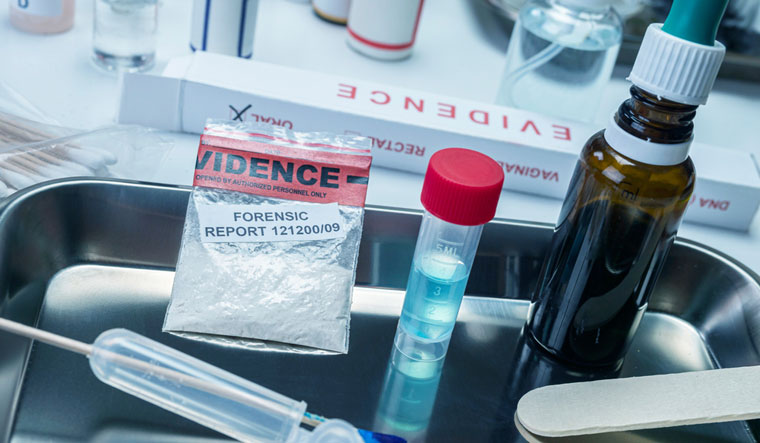Delhi Police has been granted permission by a court to conduct a polygraph test on Aftab Amin Poonawala, who allegedly killed and dismembered the body of his live-in partner Shraddha Walkar.
Aftab allegedly strangled his live-in partner Shraddha, 27, and sawed her body into 35 pieces which he kept in a 300-litre fridge for almost three weeks at his house in Mehrauli before dumping them across the city over several days past midnight.
In an order dated November 17, a Delhi court had directed the city police to complete a narco-analysis test within five days, while making it clear that it cannot use any third degree measure on him. The narco test will be conducted at Dr Baba Saheb Ambedkar Hospital in New Delhi.
The court gave permission on the ground that Aftab is providing incorrect information and misleading police.
What is a polygraph test?
 A person undergoing polygraph test | Shutterstock
A person undergoing polygraph test | Shutterstock
A polygraph test is a non-invasive technique in which no medicine is used. The purpose of the test is usually to prove whether or not a person committed a crime.
Criminal investigators use deception detection tests (DDT) such as polygraph, narco-analysis and brain-mapping on defendants to test or confirm somebody's innocence. DDTs are used widely these days when the charges are based on someone's accusations without any physical evidence or witnesses.
Crime experts use polygraph machine which picks up on a person's nervousness to assist in preliminary investigations. The subject is attached to a machine and questions are asked to him/her about the matter related to any case or incident. The variation in the graph when the subject answers the questions are mapped to draw a conclusion. However, in most democratic countries around the world, the results are not admissible in court or cannot not be used as the sole evidence in a case.
The polygraph test relies on the assumption that while lying, people show changes in physiological indicators such as blood pressure, pulse, respiration, and skin conductivity due to fear of detection.
The test involves various stages such as pretest interview, testing and post-test. Criminologists use a finger plethysmograph that monitors blood volume in a fingertip and motion sensors to monitor general movements.
The components of the polygraph include the cardio-sphygmograph, the pneumograph, and the galvanograph. Cardio-sphygmograph component that is wrapped around the subject's arm measures the blood pressure and heart rate. Galvanograph section records the amount of perspiration produced while pneumograph records respiratory movements of the chest wall.
The American Polygraph Association claims an accuracy rate above 90 per cent when done properly. However these procedures are contentious in the medical community and none of them have been demonstrated to have a 100 per cent success rate. Those who oppose the test say that a person can train to control these reactions and human behaviour cannot be determined by any kind of technology or machinery. Since people react to different levels of stress differently it is difficult to make sure whether a suspect lied or not.
Many innocent people have failed in lie detection tests in the past. People who control their physiological response by daydreaming or remembering some embarrassing experience can mislead the polygraph sensors.
Concerns regarding human rights violations in conducting these tests were raised long back and the National Human Rights Commission had published Guidelines in 2000 for the Administration of Polygraph tests
Though polygraph testing and interviewing are mostly used for event-specific investigation, they are now being used in employee screening, and pre-employment screening.
What is a narco analysis test?

Narco analysis involves intravenous administration of a drug that causes the person undergoing it to enter into various stages of anesthesia. A drug such as sodium pentothal, scopolamine and sodium amytal lowers a person's self-consciousness and makes the person in a hypnotic state or sedated state, in which their imagination is neutralised.
Therefore, the subject is likely to divulge all personal feelings wishes, desires impulses illusions, delusions, conflicts during the interrogation. The test might help to get information that would usually not be revealed in the normal state but there is no guarantee that only truth will come out.
Narco test involves a pre-narco test to ascertain the person's emotional, mental, psychological and physiological well-being. The person who asks questions could use their power and ability to deceive even in the hypnotic state, while others can become extremely suggestible to questioning.
Narco-analysis, brain mapping and polygraph tests “without consent” have been prohibited by the Supreme Court of India.
The technique offers an unrestricted access to the utmost privacy. Issues such as a physical assault on the body by giving injections and also multiple painful stimuli such as slapping, pinching, pushing, hitting, shaking the body and so forth to wake a person from hypnotic state to answer the questions are also of concern of human rights.



